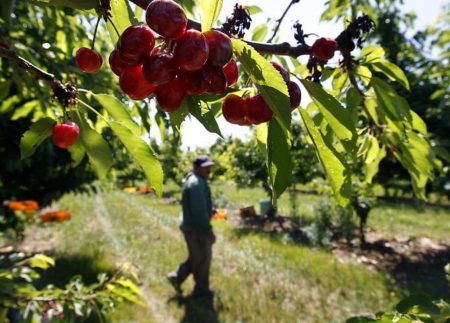December 14, 2017 – Re-engineering a fruit fly to make it sterile may be the answer that Northern California cherry orchard growers say will save their industry. The Spotted-Wing Drosophila, an imported fruit fly, that arrived from Asia a decade ago, has invaded California and is costing farmers almost $700 million in lost produce annually.
Gene-drive technology is associated with the wunderkind genetic tool CRISPR/Cas9. Using it scientists can snip out targeted strands of DNA and replace them with genetic material that alters the characteristic of a species whether it be a plant, or animal, or us. With such a powerful tool we can eliminate an entire species by interfering with its ability to reproduce. And that’s precisely what cherry orchard farmers hope can be done to end an invasion of the Spotted-Wing Drosophila.
Some scientists, however, fear the unintended consequences of unleashing gene-drive technology in the wild. When you remove a plant or animal species could it alter the ecosystem of that locale? As some scientists point out, nature tends to find a way around most of our technology fixes. Hence we get pesticide and herbicide-resistant species that appear to arise from the dead to cause damage to food crops and farm animals. Some argue that a CRISPR/Cas9 gene drive system, when unleashed into nature, could become self-propagating, acting like an invasive species.
That’s why the developers of CRISPR/Cas9 technology are cautious about taking it to market prematurely. There has to be a means to make the technology self-limiting so that when it is used to cull an invasive species it doesn’t end up creating a problem for other species. For example, if a beneficial animal that preys on Spotted-Wing Drosophila eats a gene-drive altered fruit fly, by ingesting it causes unintended DNA changes to the predator?
But getting back to the cherry growers of Northern California, it appears that the California Cherry Board along with researchers in The Akbari Lab at University of California, Riverside, have the green light to attack Spotted-Wing Drosophila and eradicate the species. Right now re-engineered fruit flies are confined to the laboratory but ultimately, the farmers want to see them released into their orchards rather than continuing to spray pesticides that kill not just the flies but helpful insects like bees. To the cherry growers, gene-drive technology appears to be a precision tool like a scalpel. Whereas their current practices are seen as using a hammer to squash a bug.
The research at Riverside funded by a $100,000 grant from the Cherry Board, goes by the project name, Medea. If you remember your Greek mythology, Medea was the wife of Jason, of Golden Fleece fame. It is told that she was a sorceress who bewitched Jason and married him. But when the spell was broken and Jason planned to leave her, she took her revenge by killing their children. A brutal image indeed, but one that fits exactly with what gene-drive technology can be used do; altering the female fruit fly’s reproductive capability and thus making any offspring unviable. In the laboratory, Medea is working with 100% of the flies in the experiment producing no live offspring.
Ther are alternatives to the Medea effect that would use gene-drive technology. Because the flies over winter by hibernating, one could use gene-drive technology to block the chemicals they use as antifreeze to help them survive the cold. Or gene-drive technology could change the flies anatomy so that it can no longer penetrate the surface of cherries to lay eggs in ripening fruit. In the latter case, the technology would not wipe out the species, but rather would make it benign, that should it spread outside California, would not pose a harm to any other region of the country.
The Cherry Board is giving the experiment five years before considering deployment in the wild. By this approach, and through education, the Board hopes to curry public favour, answering all questions before unleashing the end product of gene-drive technology into California orchards.









